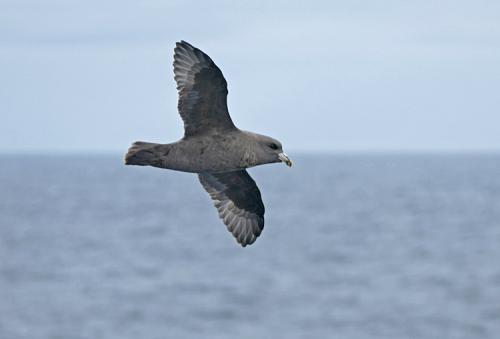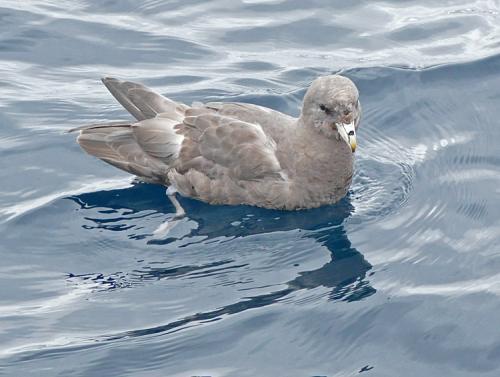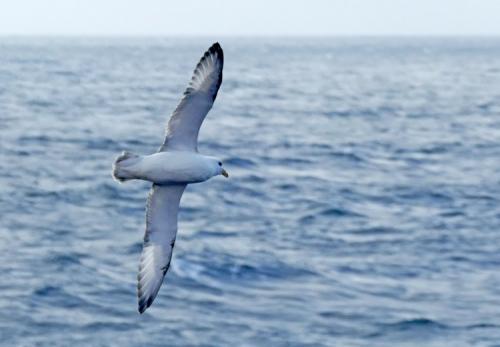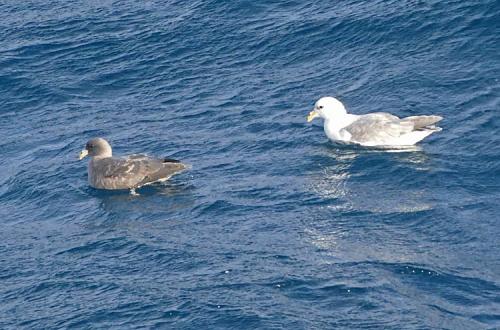Cruise Day 59
Speed 5 knots (kts)
Course 30° (NNE)
Location Chukchi Shelf, ~131 nm NW of Barrow, Alaska
Depth 42 m
GO DEEPER DISCUSSION: (see previous journal for the questions.)
The streak is from an artificial satellite orbiting the Earth. I was making two-second exposures to capture the faint aurora and stars, and so the moving satellite left a short line indicating its path of movement through the sky for those two seconds while the stars stayed put. The satellite doesn’t have lights on it like an airplane, but reflects sunlight back to the Earth.
TODAY’S JOURNAL:
After breakfast this morning the GEOTRACES sampling team suited up and reported to the fantail to get the rosette ready. Not long after we uncovered the rosette, though, we were told that science operations were on hold due to strong winds and high seas. For the rest of the day we’ve steamed into the wind and back with the wind again to stay near our intended science stations in case conditions improved enough to resume sampling (just cutting the engines and drifting allows the ship to roll uncomfortably.) With wind and waves winning the day, I spent an hour this morning and another in the afternoon up on the bridge birding. There isn’t much left in the way of birds up here north of Alaska in the Arctic Ocean despite plenty of open water remaining, with most of the seabirds taking their cue from the shortening days and lengthening nights to make their way south through the Bering Strait into seas more hospitable for wintering. I saw one loitering Thick-billed Murre and two Northern Fulmars in my two hours of standing sea watch.
 Dark-morph Northern Fulmar, Bering Sea, 12 August 2015.
Dark-morph Northern Fulmar, Bering Sea, 12 August 2015.
I thought the Northern Fulmars would be worth following up on since they have been one of the most numerous and widespread birds I’ve seen in the last couple of months. Northern Fulmars are members of the so-called tubenoses (order Procellariiformes), named for a tube-like structure on the top of their bill. Besides fulmars (two species, Northern and Southern), tubenoses include albatrosses, shearwaters, petrels, and storm-petrels. All spend essentially their whole life at sea with the exception of laying & incubating eggs and raising their chicks. They have several adaptations to fit superbly in a maritime environment. These birds have amazing flight ability- through a technique called dynamic soaring Fulmars and other tubenoses can cover incredible distances with minimal energy output. Dynamic soaring works by exploiting wind speed differences between the sheltered troughs of waves and the faster winds blowing over wave crests. Essentially these birds can generate lift by heading into the faster wind above the waves and then glide for considerable distances back along the more sheltered area along wave fronts and in the valleys between waves. Tubenoses have excellent senses of smell and sight to help locate prey near the surface, waterproof plumage, and the ability to excrete excess salt through a gland at the base of their bill. If winds drop below levels needed for dynamic soaring they can land on the ocean and hang out, paddling with webbed feet. Ranging from the tiny Least Storm-petrel (which weighs less than a House Sparrow) to the enormous Wandering Albatross (sporting a wingspan that can exceed 11 feet), tubenoses are found on every ocean on Earth.
 This swimming Northern Fulmar offered a nice look at the tube-like nasal opening on the top of the bill. Bering Sea, 10 August 2015.
This swimming Northern Fulmar offered a nice look at the tube-like nasal opening on the top of the bill. Bering Sea, 10 August 2015.
 Northern Fulmars employ stiff-winged dynamic soaring to cover a lot of territory without much muscular effort. Bering Sea, 11 August 2015.
Northern Fulmars employ stiff-winged dynamic soaring to cover a lot of territory without much muscular effort. Bering Sea, 11 August 2015.
.
Northern Fulmars are aptly named as they range farther north than any tubenose. Earlier in the cruise, I saw one at 87.8° N. latitude, only about 130 nautical miles below the North Pole. They average a 42-inch wingspan but weigh just over 1 1/4 pounds. This large wing area-to-body weight ratio (low wing loading in aerospace engineering terms) is ideal for dynamic soaring and is another shared trait of all tubenoses. The fulmars I saw today seemed entirely in their element out in the tossing seas and strong winds, arcing up over a wave and then disappearing into the trough only to emerge speeding along the next wave front without ever flapping their stiff wings. In this regard they can be identified even at a large distance, with gulls and other seabirds showing completely different flight styles. Fulmars like cold water, with some wintering as far north as the southern Bering Sea. Their scientific name, Fulmarus glacialis, reflects their fondness for icy waters. Unlike any other seabird encountered on our cruise, Northern Fulmars come in different color morphs. Many we’ve seen are dark gray, some light gray, and some nearly white. Quick to find feeding opportunities, Northern Fulmars will follow fishing boats to feed on bycatch (fish caught unintentionally in nets and thrown back) and discarded bait. If you’ve ever watched Deadliest Catch, you’ve seen Northern Fulmars swirling around the crabbing boats even at night in the nastiest stormy weather. On this expedition they have broken many long birdless spells for me, and I look forward to seeing more as we head back through the Bering Strait on our way home.
 This pair of Northern Fulmars shows a nice comparison between a lighter bird and a darker bird. Bering Sea, 11 August 2015.
This pair of Northern Fulmars shows a nice comparison between a lighter bird and a darker bird. Bering Sea, 11 August 2015.
GO DEEPER!
Besides birds, there is another class of vertebrates with some species spending their entire lives at sea with the exception of laying eggs on land. Can you name this taxonomic class?
Aloft Con web cam updated every hour
Healy Track
That's all for now. Best- Bill

